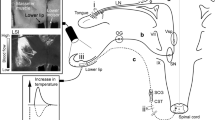Abstract
The role of nasal heat exchange in the control of brain temperature has been studied in cats, pigs, ducks and rabbits during acute experiments under general anaesthesia. Nasal air flow at physiological rates caused hypothalamic temperature to fall at beween 0.2 and 0.5°C/min in cats, pigs and ducks, which all have arterial rete systems that can cool blood flowing to the brain, but not in rabbits, which lack an arterial rete. Bilateral stimulation of cervical sympathetic trunks reduced or abolished the brain cooling effect of nasal air flow in cats, pigs and ducks. After a period of airflow during which brain cooling was reduced by sympathetic stimulation, the end of stimulation was sometimes followed by marked and rapid brain cooling, indicating re-perfusion through ischaemic cooled tissues. Cervical sympathetic stimulation caused a reduction in resistance to nasal airflow in all species studied, by inducing vasoconstriction and shrinkage of the nasal mucosa. In species with well-developed arterial retia, the effect of cervical sympathetic stimulation in regulating nasal cooling of the brain is probably mediated by controlling blood flow through the nasal mucosa. Although this vascular control also occurs in rabbits, they cannot selectively cool the brain and sympathetic stimulation has no effect on rabbit brain temperature.
Similar content being viewed by others
References
Alm A, Bill A (1973) The effect of stimulation of the cervical sympathetic chain in retinal oxygen tension and on uveal, retinal and cerebral blood flow in cats. Acta Physiol Scand 88:84–94
Baker MA (1972) Influence of the carotid rete on brain temperature in cats exposed to hot environments. J Physiol 220:711–728
Baker MA (1982) Brain cooling in endotherms in heat and exercise. Ann Rev Physiol 44:85–96
Baker MA, Hayward JN (1967) Automatic basis for the rise in brain temperature during paradoxical sleep. Science 157:1586–1588
Baker MA, Hayward JN (1968) The influence of the nasal mucosa and the carotid rete upon hypothalamic temperature in sheep. J Physiol 198:561–579
Beausang-Linder M, Hultcrantz E (1980) Early effects of cervical sympathetic stimulation on cerebral ocular and cochlear blood flow. Acta Physiol Scand 109:433–437
Bech C, Midtgārd U (1981) Brain temperature and the rete mirabile ophthalmicum in the Zebra finch (Poephila guttata). J Comp Physiol 145:89–93
Bernstein MH, Curtis MB, Hudson DM (1979a) Independence of brain and body temperatures in flying American kestrels,Falco sparverius. Am. J. Physiol 237:R58–R62
Bernstein MH, Sandoval I, Curtis MB, Hudson DM (1979b) Brain temperature in pigeons: effects of anterior respiratory bypass. J Comp Physiol 129:115–118
Cabanac M, Caputa M (1979) Natural selective cooling of the human brain: Evidence of its occurrence and magnitude. J Physiol 286:255–264
Caputa M, Kadziela W, Narebski J (1976) Significance of cranial circulation for the brain homeothermy in rabbits. II. The role of the cranial venous lakes in the defence against hyperthermia. Acta Neurobiol Exp 36:625–638
Daniel PM, Dawes JDK, Prichard MML (1953) Studies of the carotid rete and its associated arteries. Philos Trans R Soc Lond (Biol) 237:173–208
Davis DD, Story HE (1943) Carotid circulation in the domestic cat. Publ. Field Mus Natl Hist (Zool) 28:1–47
Eceles R, Eccles KSJ (1981) Sympathetic innervation of the nasal mucosa of the pig. Res Vet Sci 30:349–352
Ganong WF (1977) Review of medical physiology (8th ed.). Lange Medical Publications Los Altos, California, pp 458–459
Gordon CJ, Rezvani AH, Fruin ME, Trautwein S, Heath JE (1981) Rapid brain cooling in the free-running hamsterMesocricetus auratus. J Appl Physiol 51:1349–1354
Godynicki S (1975) Blood vessels of the nasal cavity in the rabbit. Folia Morphol (Warsz) 34:69–76
Hayward JN, Baker MA (1968) The role of the cerebral arterial blood in the regulation of brain temperature in the monkey. Am J Physiol 215:389–403
Hayward JN, Baker MA (1969) A comparative study of the role of the cerebral arterial blood in the regulation of brain temperature in five mammals. Brain Res 16:417–440
Heistad DD, Marcus ML, Sandberg E, Abboud FM (1977) Effect of sympathetic nerve stimulation on cerebral blood flow and on large cerebral arteries of dogs. Circ Res 41:342–350
Kilgore DL, Bernstein MH, Schmidt-Nielsen K (1973) Brain temperature in a large bird, the rhea. Am J Physiol 225:739–742
Kilgore DL, Bernstein MH, Hudson DM (1976) Brain temperatures in birds. J Comp Physiol 110:209–215
Kilgore DL, Boggs DF, Birchard DF (1979) Role of therete mirabile ophthalmicum in maintaining the body-to-brain temperature difference in pigeons. J Comp Physiol 129:119–122
Kluger MJ, D'Alecy LG (1975) Brain temperature during reversible respiratory by-pass. J Appl Physiol 38:268–271
Malm L (1973) Stimulation of sympathetic nerve fibres to the nose in cats. Acta Otolaryngol (Stockh) 75:519–523
Richards SA (1970) Brain temperature and the cerebral circulation in the chicken. Brain Res 23:265–268
Schmidt CF (1934) The intrinsic regulation of the circulation of the hypothalamus of the cat. Am J Physiol 110:137–152
Winquist RJ, Bevan JA (1980) Temperature sensitivity of tone in the rabbit facial vein: myogenic mechanism for cranial thermoregulation? Science 207:1001–1002
Author information
Authors and Affiliations
Rights and permissions
About this article
Cite this article
Bamford, O.S., Eccles, R. The role of sympathetic efferent activity in the regulation of brain temperature. Pflugers Arch. 396, 138–143 (1983). https://doi.org/10.1007/BF00615518
Received:
Accepted:
Issue Date:
DOI: https://doi.org/10.1007/BF00615518




